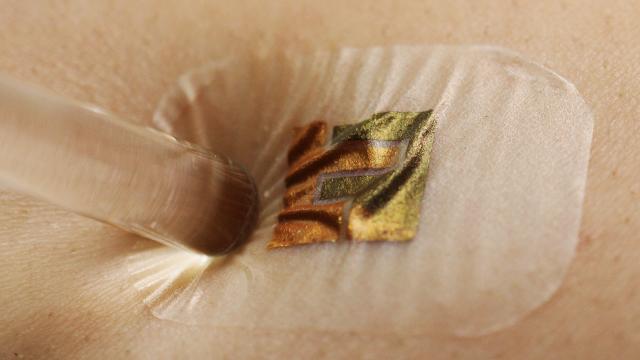Measuring your blood sugar may be weirdly trendy, but it you’re one of the 30 million Americans with diabetes, it’s mostly a pain. A literal pain. People with diabetes either have to prick their fingers and draw blood or wear a monitor with a tiny tube inserted into their skin to continuously measure glucose in the fluid between cells. And sticking a needle in yourself isn’t exactly pleasant.
A new biosensor described in a paper published Wednesday in Science Advances suggests a workaround. Instead of a finger prick, an extremely thin, skin-like patch instead uses electrical signals to drive glucose out of nearby blood vessels to the skin’s surface to be measured. The whole thing is powered by a paper battery, and looks a little like a trendy temporary tattoo.
In a very small clinical trial of two healthy subjects and a third with diabetes, the device measured blood glucose levels almost as well as a standard clinical blood test during a five-day study. None of the patients reported any irritation or discomfort.
A noninvasive or minimally invasive blood glucose monitor is a kind of a holy grail. Not only would it be a huge upgrade in lifestyle for those with diabetes but it could solve some of the problems with patient compliance created by pain, skin irritation, and infections. Not to mention that 30 million people who need to continually monitor their glucose levels is a massive market. There’s been several approaches to doing this, many of them consumer devices that have targeted the wellness market rather than people with diabetes, thus evading FDA regulation. One popular approach uses sweat to measure glucose levels. Earlier this year, rumours circulated that Apple is even chasing a needle-free blood sugar monitor. You might remember that Google also tried to develop a contact lens to detect glucose in tears.
But so far, all of those attempts have run into problems. To start, there’s not very much glucose floating around in your blood, so if your using something like sweat to measure glucose levels, there’s just not that much to go on. Blood sugar spills over into tears, spit, sweat, or urine if levels are too high, but as levels drop it becomes virtually undetectable without breaking the skin. Even finger prick tests can wind up with inaccurate results. And if someone is diabetic, inaccurate results could be dangerous, driving people to take insulin if they don’t need it or skip it when they do.
Other approaches have tried measuring changes in the body that result from changes in glucose, like how light reflects off of skin, but there are problems there too. Lots of other molecules cause the kind of measurable changes glucose does, making accuracy difficult.
Right now, there aren’t any FDA-approved noninvasive glucose trackers on the market.
But Yihao Chen, one of the authors on the new study from Tsinghua University in China, told Gizmodo his device might be different. Calibrated properly, he said, the system could be suitable for medical-grade continuous glucose monitoring.
Still, the study was small and the research is in early stages. Much more work is needed to determine how accurate and easy-to-use this patch really is.
